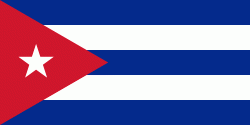Caimanera
Caimanera is a municipality and town in Guantánamo Province on the south eastern coast of Cuba. It is a fishing village and port built on the West shore of the sheltered Guantánamo Bay, just north of the US naval base and south of the provincial capital, Guantánamo.
The town was named for the caiman alligators which were once common in the river and in the mangrove labyrinths of the upper Bay, but which have since declined in numbers.
The community of fishermen and salt mine workers flourished at the beginning of the 20th century precisely because of the base's construction. It was a magnet for Cuban workers and a popular spot for visitors, including Cubans from across the island and people from nearby countries such as Jamaica.
Caimanera was liberated on December 19, 1958. On this anniversary the town usually has a parade and a political action.
The Havana Times reports that in 1959, not long after the Cuban Revolution drove out the pro-American Battista administration, two US Navy tugboats came to Caimanera to apply their powerful water-cannons to put out a raging fire that destroyed three city blocks.
The Cuban Revolution of 1959 marked strained relations between Cuba and America, in general, and specifically between the inhabitants of Caimanera and the nearby Guantanamo Bay Naval Base. Prior to the revolution off-duty US personnel from the base were free to visit Caimanera, and the town was home to many bars and bordellos, that catered to them. The base employed over three thousand Cuban workers. Cuban contractors, who employed the workers, whisked them to their jobs on the base in speed-boats.
After the revolution, both sides made policy changes. Cuba allowed workers to continue to work on the base, but they had to walk to the remote North-East Gate. The USA would continue to employ those Cubans who already had jobs, but would not hire any new Cuban workers. The number of Cuban workers dwindled, with the last two retiring in 2012.
The town was named for the caiman alligators which were once common in the river and in the mangrove labyrinths of the upper Bay, but which have since declined in numbers.
The community of fishermen and salt mine workers flourished at the beginning of the 20th century precisely because of the base's construction. It was a magnet for Cuban workers and a popular spot for visitors, including Cubans from across the island and people from nearby countries such as Jamaica.
Caimanera was liberated on December 19, 1958. On this anniversary the town usually has a parade and a political action.
The Havana Times reports that in 1959, not long after the Cuban Revolution drove out the pro-American Battista administration, two US Navy tugboats came to Caimanera to apply their powerful water-cannons to put out a raging fire that destroyed three city blocks.
The Cuban Revolution of 1959 marked strained relations between Cuba and America, in general, and specifically between the inhabitants of Caimanera and the nearby Guantanamo Bay Naval Base. Prior to the revolution off-duty US personnel from the base were free to visit Caimanera, and the town was home to many bars and bordellos, that catered to them. The base employed over three thousand Cuban workers. Cuban contractors, who employed the workers, whisked them to their jobs on the base in speed-boats.
After the revolution, both sides made policy changes. Cuba allowed workers to continue to work on the base, but they had to walk to the remote North-East Gate. The USA would continue to employ those Cubans who already had jobs, but would not hire any new Cuban workers. The number of Cuban workers dwindled, with the last two retiring in 2012.
Map - Caimanera
Map
Country - Cuba
 |
 |
| Flag of Cuba | |
The territory that is now Cuba was inhabited by the Ciboney people from the 4th millennium BC with the Guanahatabey and Taíno peoples until Spanish colonization in the 15th century. From the 15th century, it was a colony of Spain, and slavery was abolished in 1886, remaining a Spanish colony until the Spanish–American War of 1898, when Cuba was occupied by the United States and gained independence in 1902. In 1940, Cuba implemented a new constitution, but mounting political unrest culminated in a coup in 1952 and the subsequent dictatorship of Fulgencio Batista, which was later overthrown in January 1959 by the 26th of July Movement during the Cuban Revolution, which afterwards established communist rule under the leadership of Fidel Castro. The country was a point of contention during the Cold War between the Soviet Union and the United States, and a nuclear war nearly broke out during the Cuban Missile Crisis of 1962. Following the collapse of the Soviet Union, Cuba faced a severe economic downturn in the 1990s, known as the Special Period. In 2008, Fidel Castro resigned after 49 years of leadership of Cuba and was replaced by his brother Raúl Castro.
Currency / Language
| ISO | Currency | Symbol | Significant figures |
|---|---|---|---|
| CUC | Cuban convertible peso | $ | 2 |
| CUP | Cuban peso | $ | 2 |
| ISO | Language |
|---|---|
| ES | Spanish language |















